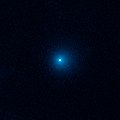Top Qs
Timeline
Chat
Perspective
C/2017 K2 (PanSTARRS)
Oort cloud comet From Wikipedia, the free encyclopedia
Remove ads
C/2017 K2 (PanSTARRS) is an Oort cloud comet with an inbound hyperbolic orbit, discovered in May 2017 at a distance beyond the orbit of Saturn when it was 16 AU (2.4 billion km) from the Sun.
Remove ads
Observational history
Precovery images taken from 2013 were located by July 2017.[8] It had been in the constellation of Draco from July 2007 until August 2020. As of June 2022[update], the 3-sigma uncertainty in the current distance of the comet from the Sun is ±6000 km.[9]
Physical characteristics
Summarize
Perspective
The comet is record breaking because it was already becoming active at such a distance. Only Comet Hale–Bopp produced such a show from that distance with a similar nucleus. However, this comet will not be as visible as Hale–Bopp was in 1997 in part because it does not come nearly as close to the Sun.[b] Astronomers had never seen an active inbound comet this far out, where sunlight is 1/225th its brightness as seen from Earth. Temperatures, correspondingly, are at −262.2 °C (−440 °F) in the Oort cloud. However, as it was approaching the Sun at a distance of 16 AU at discovery, a mix of ancient ices on the surface containing oxygen, nitrogen, carbon dioxide and carbon monoxide began to sublimate and shed the dust frozen into it. This material expands into a vast 130,000 km (81,000 mi) wide halo of dust, called a coma, enveloping the solid nucleus.[10] Outgassing of carbon monoxide was detected when the comet was 6.72 AU (1,005 million km) from the Sun.[11]
Research with the Canada–France–Hawaii Telescope (CFHT) infers the comet nucleus to have a radius between 14–80 km (8.7–49.7 mi), so there is a chance the nucleus could be as large as C/1995 O1 (Hale–Bopp).[12] However, research with the Hubble Space Telescope (HST) estimates the nucleus to have a circular equivalent diameter of less than 18 km (11 mi).[13] Near-infrared observations conducted by the James Webb Space Telescope in 2023 revealed a much smaller nucleus, estimated to be less than 8.4 km (5.2 mi) in diameter.[5][14] On 17 September 2020, morphological studies of the inner coma, observed on 12 September 2020, were reported, noting that two jet-streamed structure were emitted from the nucleus and, as well, that the length of the tail was about 800,000 km (500,000 mi) long.[15]
On 27 July 2021, further detailed observations of the comet about its jet-shaped dust emissions were reported on The Astronomer's Telegram.[16]
Remove ads
Orbit
The comet was within 5 AU (750 million km) of Earth by 11 January 2022.[17] Around 6 July 2022, the comet crossed the celestial equator, and then on 14 July 2022, it passed 1.8 AU (270 million km) from Earth[18] and shone around 9.0 magnitude making it a decent binoculars object.[19][20] It reached perihelion on 19 December 2022, close to the orbit of Mars, and was not visible to naked eye at 8.0 magnitude.[4][20][a]
JPL Horizons models that C/2017 K2 took millions of years to come from the Oort cloud at a distance of roughly 50,000 AU (0.79 ly).[2] The heliocentric orbital eccentricity drops below 1 in December 2023.[21] The outbound orbital period will be around 25,800 years with aphelion being around 1,750 AU (262 billion km).[2] There was a dispute whether that was the first time the comet entered the inner Solar System, but its orbit suggests that the comet is not dynamically new and there is a 29% chance that the comet is of interstellar origin and was captured by the Solar System within the last 3 million years.[22][23]
Gallery
- June 2017 by Hubble's Wide Field Camera 3[24]
- 11" fast Astrograph on 2022-07-16 while near Messier 10
- Path of C/2017 K2 in the sky
References
External links
Wikiwand - on
Seamless Wikipedia browsing. On steroids.
Remove ads




